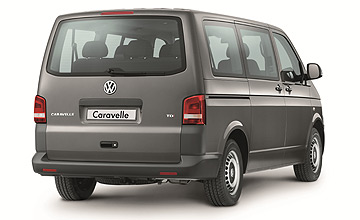BY PHILIP LORD | 24th Jun 2010

Just as much a given is where the punters won’t pause for a perve, and that at the stand occupied by the new Volkswagen Caravelle.
That’s okay not everyone’s dream car is a shoebox-style nine-seat bus. Maybe hotel shuttle operators will slow and calculate if the new Caravelle’s price reduction (down about $5k) will translate into more affordable operating costs.
Volkswagen enthusiasts or those looking for a quality, durable people-mover for their brood might also stop for a moment, trying to justify the Caravelle as their next family car.
Maybe some mums and dads – you know the type, dark rings under their twitching eyes, their faces perpetually wearing a lost look, etched there by sleep deprivation – may slow at the Volkswagen stand, wondering how long it’ll take for the sales staff to notice the kids using the Caravelle’s cavernous passenger compartment as play equipment.
The T5 GP is more than a nose job – the sheetmetal from the B-pillar forward is new, and more in line with current VW styling. The new design looks good, in that squared-off German style, but also wears the new theme with the old one (that is, the carry-over T5 body from behind the front doors) well.
Saying it is elegant might be a stretch, but unless your preference is on the SsangYong Stavic end of the people-mover spectrum, it is a smart-looking bus.
The Caravelle’s interior feels bombproof-solid, with hard-wearing materials and industrial-grade seat frames, but it is not luxurious – which will suit most intended customers just fine.
The leather-lined Multivan Highline further up the model range serves that purpose, but you can’t help but feel that the Caravelle is a bit plain for $50k, and certainly while it appears better finished than the mid-$30k Koreans, the Carnival and iMax, it does not feel any more luxurious.
The seat layout is versatile and will ensure that shuttle bus operators won’t have too many customers complaining about a lack of room. In the back, it has a well-spaced, easy to access two rows of two seats and back row of three seats.
The Caravelle’s dual rear sliding doors are becoming more commonplace in this class, and why not. Dual (front/rear) air-conditioning controls, as featured in the Caravelle, are also proliferating.
While installing booster seats is not a problem – theoretically, you could carry a brood of seven in the back – the lack of seat anchor points (there are just two in the second row seats) will be a sore point if the Caravelle is a mum’s taxi used for kids in child seats and/or harnesses with booster seats.
A good passenger compartment doesn’t translate into a big cargo area for many people-movers, and that’s why you’ll see many used as shuttles also towing a luggage trailer. The Caravelle’s space is not bad, but a big family will fill it fast on a holiday.
Each of the three back seat rows can be either folded down (seatback on to the seatbase) or removed. It is not a patch on other people-movers such as the Kia Grand Carnival in terms of seat folding sophistication. The Caravelle does not have, for example, the Grand Carnival’s in-floor rear seats folding arrangement
To take advantage of the cargo space in lieu of occupant space is a Herculean task. The rear-most seat row is the most logical to remove but also the heaviest. It would be impossible for one average person to remove it, and even two would struggle. Not to mention finding a place at home to store something the size of a park bench.
The new turbo-diesel is a sweet engine that begins its sweep though the rev range with adequate response down low, a strong mid-range and a eagerness to rev up to the redline – unlike many diesels.
It is relatively quiet and smooth and while it isn’t whip-quick, it yields crisp response in the entire rev range bar just off-idle, where the turbo lag is noticeable but not objectionable.
Fuel consumption reached the 11.5L/100km mark in an urban mix and got down to 9.1L/100km on the open road.
The engine’s amenable nature is not completely mirrored by the transmission, which is snappy, decisive and predictable in its gearshifts on the open road or in more free-flowing traffic – but in stop-start city driving, it becomes irritable, confused and dithers.
When doing a three-point turn you can’t rely on crisp Drive to Reverse shifts or vice-versa – a time delay only gets worse if the Caravelle rolls forward slightly (which is hard to avoid, given the camber on most roads) as the electronics don’t like the idea of reverse being selected while rolling forward.
That makes sense, but try explaining that concisely to the traffic queue waiting for you to move on.
The lack of standard parking sensors on such a big vehicle likely to see much urban use is a surprise, too.
Despite the high level of road noise reflected into the cabin, the Caravelle is one of the most enjoyable people-movers to ride in or to drive. The precise steering, satisfactory tyre grip and generally predicable demeanour of the chassis won’t have GTI drivers jealous, but more satisfying in a van than you might expect.
The Caravelle’s utilitarian feel makes it seem more aimed at shuttle bus operators and fleets than families, but either way the abundance of comfort, room, safety features and a strong diesel engine may overshadow the lack of the DSG transmission’s around-town performance.